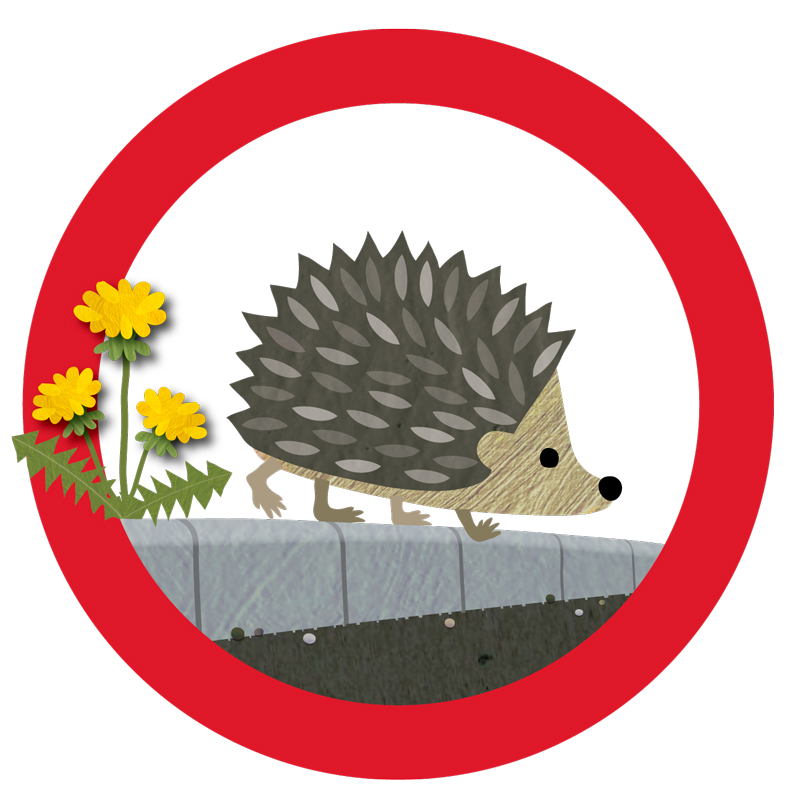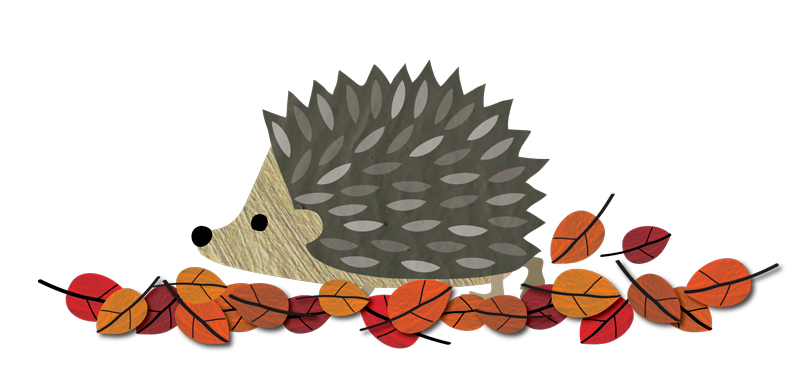
Nearly a quarter of the hedgehogs born into the world die before leaving their nest; about half of the rest do not survive to adulthood. We can all assist hedgehogs that have endured these early adversities in several ways.
- Provide a safe environment in gardens and allotments. Always garden with wildlife in mind, leave a corner or edge as a wildlife sanctuary. You could be rewarded by the pleasure of seeing visiting hedgehogs and other wildlife, as well as the knowledge that they will help clear the ground of pests.
- Collect materials – logs, leaves, brushwood, etc. – that hedgehogs can use to build nests or shelter in. Nests are refuges by day, vital for breeding and winter survival depends on hibernation nests (hibernacula).
- Supplement their natural diet of beetles, worms, caterpillars and suchlike with some protein (e.g. meat based pet food, or crunchy meaty hedgehog/cat biscuits), particularly in periods of unseasonable weather. Splitting food over several sites might help reduce aggressive interactions at food bowls, or try scattering food to encourage more natural foraging behaviour. A bowl of clean drinking water should also be available at several sites around the garden.
- Seek advice and take immediate action when you see a hedgehog or hoglet in trouble.
- Help them to avoid man-made hazards and eliminate or reduce such dangers whenever possible.
ON THE ROADS
Most of us see more squashed hedgehogs than live ones. Their natural defence mechanism – rolling into a ball – is no protection against road traffic. All nature-loving people want to do something about this carnage. So, do drive carefully, especially at night, do all you can to avoid hedgehogs that may be crossing the road and if it is safe to do so stop and assist hedgehogs to get across quickly but never take a healthy hedgehog away from its environment to somewhere you deem to be safer, it may well leave dependent young behind or be unable to survive at the new unfamiliar and possibly unsuitable site. Ask your friends to be kind to hedgehogs on our roads too. When you do see this sad sight please be sure to log it if possible at www.bighedgehogmap.org. We have a ‘road sign’ available in our online shop that can be placed on private property to warn drivers that hedgehogs are in the area. Another option is to make your own, or get the local school involved in a competition to design a sign and use laminated print outs of the winning one.
MAKE YOUR MOTTO – SLOW DOWN FOR WILDLIFE
IN FARMING AREAS
Hedgehogs and many other small animals, as well as birds, frequently cannot escape from the sheer-sided pits beneath cattle and sheep grids. This results in a long drawn out death by dehydration and/or starvation. A simple ramp in the grid solves this problem – ask your cattle grid stockists about hedgehog escape ramps. As part of our Hedgehog Street project with People’s Trust for Endangered Species, we have produced guidance for farmers wanting to help hedgehogs. ‘Hedgehog Street – Farmers Guidance’ can be found on our website. Please call if you cannot access the online version.
IN GARDENS
Pesticides are potentially dangerous to hedgehogs and slug pellets are no exception. Hedgehogs may eat the pellets, and they are very likely to eat the poisoned slugs and snails. In April 2022 the outdoor use of metaldehyde slug pellets was banned and it is also illegal to sell or supply metaldehyde slug pellets for outdoor use in the UK. We advise you do not use garden chemicals. Alternatives to chemicals can work very well, for example copper bands and tape are available to place round the base of plants or pots. “Beer-traps” (i.e. a bowl of beer or milk sunk in the ground) can be an effective way of killing slugs, but make sure hedgehogs cannot access it to drink. In any case, as an extra precaution, all dead slugs should be regularly removed. Some people have reported success at protecting plants by sprinkling coffee grounds round the base (coffee shops will often let you have these for free). Any form of pest control affects the hedgehogs’ food chain, but barrier products like the copper and coffee grounds mentioned above means the prey remains healthy and safe for the hedgehog to eat.
Garden rubbish frequently provides a home for hedgehogs and should be carefully checked before burning. It is safer to make your bonfire on the day it is to be lit or to use a garden incinerator specifically designed for burning rubbish. The larger heaps that accumulate for 5th November, of course, should always be checked prior to the night festivities and preferably resited on the day. To keep hedgehogs out of the bonfire, or away from other hazards (e.g. holes in the ground), you can surround the site with an effective barrier such as ‘amphibian fencing’, the vertical plastic barriers used by ecologists to exclude amphibians. Always light bonfires from one side only to offer an escape route for anything you may have missed.
Grass, especially if a little longer than usual, is another possible home for hedgehogs and care is needed before mowing and strimming. Cut the grass to a more reasonable length and then check again for hedgehogs and other wildlife. Never burn pampass grass without first checking there are no hedgehogs using it as a nesting place.
Garden ponds can present a danger, hedgehogs can swim and are sometimes attracted to them, but they may drown if they cannot get out. Gardeners should ensure that there are slipways around the edge of the water to enable the hedgehogs to escape – half submerged rocks or even a piece of chicken wire to be used like a scrambling net are suggested. Pond levels should be kept topped up.
Netting of all kinds – that used for covering plants and fruit, as well as tennis nets, fishing nets and suchlike – can be a major hazard as hedgehogs easily become entangled in them. Any hedgehog found in netting should be taken to an independent hedgehog rescue centre as soon as possible because even if all the netting is removed, the friction caused by the hedgehog trying to escape can cause skin to break down several days later. Their inquisitiveness can also get them into trouble if their head gets stuck in various kinds of containers – empty food cans, yoghurt pots, plastic cups and fast food containers, etc.
The plastic rings that hold 4 and 6 packs of cans together and elastic bands are a problem too, because wildlife, including hedgehogs, can get trapped in them. Always make sure the bands and circles are cut through and as with all litter, disposed of responsibly.
AROUND & ABOUT
Hedgehogs are sometimes subjected to deliberate cruelty. This is illegal. Should you see this occurring please contact the police and RSPCA immediately. If the unfortunate hedgehog is injured, get it to a Vet or a local independent hedgehog rescue centre as a matter of urgency. In any case, please also let the British Hedgehog Preservation Society know about it.





